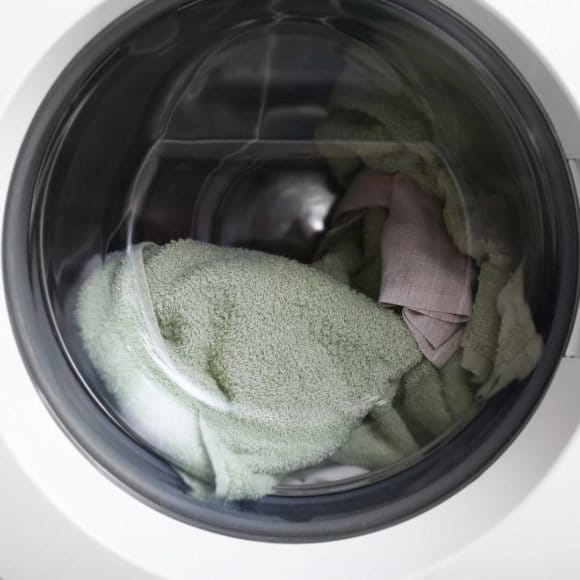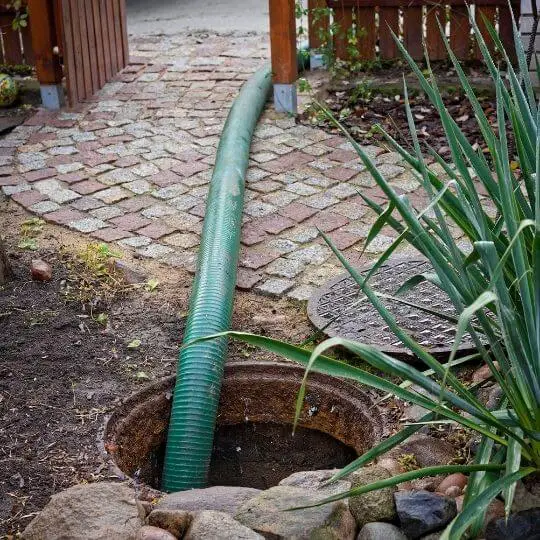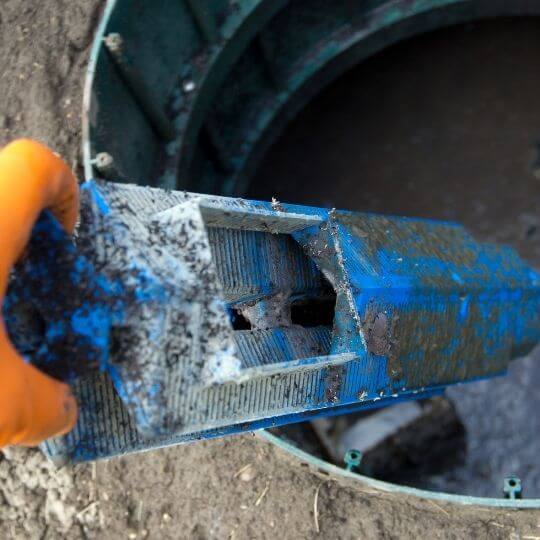If you ever wondered if the septic tank overflows when washing clothes, then you are at the right place. When we talk about septic tank system backups, the first association is always problems with the toilets.
However, it just so happens that washing your laundry can impact the function of a septic tank as well.
But this isn’t a cause for concern! Using a washing machine that drains into a septic tank is completely possible and manageable.
You just need to apply some tricks and be more cautious of some things while doing so. Stay with us as we discover how to make a machine connected to a septic tank work like a charm!
Septic Tank Overflows When Washing Clothes

When you start researching this topic online, soon you’ll encounter plenty of horror stories about this.
It just seems like washing machines are simply not meant to be used with the septic tanks. Is this true?
Actually, no! It’s perfectly okay to use washing machines when your draining system is connected to a septic tank.
The trick is just to be more cautious about how you use your washing machine. These tricks have to do with washing machine maintenance, as well as with the amount of laundry and type of detergent used.
When you adjust these things, you’ll no longer need to worry about encountering a flood around your septic tank. When you learn how to do it more efficiently, you also ensure that the sewer system lasts longer.
Septic Tank Smell When Doing Laundry
We tend to associate doing laundry with clean and fresh smells for obvious reasons.
When you encounter bad smells when doing laundry, this just makes the whole experience much worse. It can be very discouraging when you’re dealing with the sewer smell while trying to wash your clothes.
Although we’d love to give you a one-for-all solution, this particular situation is not that simple.
There can be a couple of things causing the sewer smells when your house is connected to the septic tank. Let’s take a look at the most common ones and how to solve them:
- Dry P-Trap
Similar to toilets, washing machines also have a P-Trap. A P-Trap serves to block the sewer gases from entering your home. [1]
When the P-Trap is dry, then the sewer smells enter your home and cause bad smells when you do your laundry. A quick solution to this is to pour a gallon of water into the P-Trap of the washing machine.
- Clogged Drain
Washing machine drainage problems can be caused by numerous things from your clothes causing the clog. Things like hair, dust particles, and soap can easily cause a clogged drain, which leads to bad smells.
The solution to this is to unclog the drain. If you’re unsure of how to do it yourself, it’s probably best to phone a professional.
- Clogged Vent Pipe
The vent pipe of the washing machine also has a role in blocking the sewer smells from entering the home. It needs to be unblocked as the clog is what causes the bad smell too.
- Bacterial Growth
Sometimes, it’s little pieces of soap, dust, or other similar particles that get stuck in the washer. This alone can cause a really bad smell because it can lead to bacterial growth or mold.
A simple solution to this is to clean the inside of the washer with some vinegar and water solution (1:1 ratio).
CONCLUSION: As you can see, all of these problems causing the bad smells may or may not be linked directly to your septic tank.
However, if you find that your septic tank overflows and is accompanied by a sewer smell in the washer, that’s different.
Then that means that you need to make some adjustments to your laundry routine and septic tank maintenance.
What Does It Mean When Your Septic Tank Overflows?

A traditional septic tank system can usually work well for a really long period if maintained properly.
A septic tank works in a way that it first collects all of the wastewater from your house. Then, it breaks down the components inside the tank into three different levels.
The bottom part (sludge), the middle part (liquid effluent), and the top part (scum or oils).
The middle layer consisting of filtered water or effluent, then leaves the tank and travels onto the drain field.
When this system is disrupted, the wastewater coming to the tank surpasses its capacity. This is when a septic tank overflows, creating a flood in your yard.
Before this happens, you should watch out for the warning signs of a full septic tank.
Many factors can lead to this, such as flushing certain things or slushing medicine like probiotics. However, a washing machine used inefficiently can also negatively impact the septic tank.
How Washing Machine Impacts Septic Tank

There is actually not one – but many different ways in which a washing machine can impact the septic tank negatively.
But worry not – in this part of the article, you’ll get to know what these things are. By knowing how these things are connected, solving the problem gets much easier!
- Too Many Loads of Laundry
This one is the most obvious one. Doing many loads of laundry with short pauses in between puts a lot of pressure on your septic system.
That’s because all of that wastewater can’t exit the tank in time for it to welcome new loads of water. This is what often happens with large families who wash multiple loads of laundry in short periods of time.
Naturally, the best solution for this is to spread out the washing time. It’s better to wash a couple of loads per week than to wash multiple ones in a day.
- Too Much Water
Logically, with washing multiple loads of laundry in one sitting, more water travels to the tank at once.
Newer washing machine models have become more efficient in using less water to wash the same amount of laundry.
So, if that’s an option for you, you can consider looking into purchasing a newer model.
- Too Much Laundry Detergent
A septic tank relies on beneficial bacteria in order to break down the solids from the wastewater. However, numerous things can kill these bacteria, such as antibiotics after they are flushed. [2]
Another thing that can mess with the bacterial levels in the tank is the laundry detergent. This happens when too much detergent is used.
In contrast, some products can be beneficial – vinegar is safe for septic systems.
A large amount of laundry detergent can’t dissolve properly in the wash cycle, so the residue of it gets stuck in the washer. This creates bad smells.
When chunks of this detergent residue fall off, they travel to the septic tank, causing further clogs along the way.
- Using Powder Laundry Detergent
It’s wrong to use any form of laundry detergent in large amounts.
But when it comes to powdered laundry detergents, things can get even more complicated. This is because most powdered ones contain fillers that are not biodegradable. [3]
This creates residue, which forms in chunks that travel and cause further clogs and bad smells.
- Dirty Lint Filter
Whilst cleaning the lint trap in the dryer is common, that’s usually not the case for the washer.
It’s beneficial to know that the washer also has a lint filter. This filter can get clogged, especially when it comes to older machines.
The debris from this filter can travel to the tank and cause more problems. This filter needs to be cleaned for fuzz-free and nice-smelling clothes once again. [4]
How Many Loads of Laundry Can I Do With Septic Tank?

This is the most common question from people every time a septic tank overflows when washing clothes.
Our advice is not only to adjust the number of loads. It’s best to also learn about some other ways to protect the tank while doing laundry:
- Get Into The Habit of Cleaning the Filters
As you can see, the filters in and around the washer are some of the most overlooked parts of it. When we encounter a washing machine problem, we immediately rush to solve visible problems.
Also, most of us don’t have a habit of cleaning out the inner parts of the washer. However, if you get into a habit of cleaning the lint filters regularly, you’ll save yourself a lot of trouble with a septic tank.
- Adjust The Number of Loads
The most obvious solution is always to adjust the number of laundry loads. We all have different needs and habits when it comes to our laundry routines.
There’s also no full-proof guideline out there that’ll tell you how many loads you can wash. The best piece of advice is to just spread out the washing loads and avoid washing more than one load per day.
- Consider Purchasing a New Machine
As stated earlier, newer machine models are just more efficient. They are efficient in a way that they simply use less water to wash the same amount of clothes. [5]
This also means less time to wash and lower electricity and water bills. Consider investing in a new washer, as it will certainly pay off.
- Use Correct Laundry Detergents
Finally, consider taking a closer look into what type of laundry detergents you’re using.
You should also research what to put in a septic tank to break down solids.
You’d be surprised to find out that the extra detergent actually has the potential to really harm the septic system.
Septic tanks rely on beneficial bacteria to break down the waste. Introducing harmful chemicals can kill these bacteria and throw off the balance of the tank completely.
Let’s look into some septic-tank-safe laundry detergents.
Septic Tank Laundry Detergent
Enjoying the article so far? Check out our article on bamboo toilet paper being septic safe, we think you’ll like it!
Here’s our pick of some of the best septic-safe laundry detergents:
Best Overall: Arm & Hammer Sensitive Skin Free & Clear
This is a highly concentrated formula that uses less water – which is exactly what’s needed for the septic tank. It’s clinically and dermatologically tested by healthcare professionals.
It’s best overall because it’s as powerful for cleaning as it’s gentle on the skin. It has no added perfumes, dye, or preservatives and is hypoallergenic.
Budget-Friendly: Mrs. Meyer’s Liquid Laundry Detergent
This is a biodegradable, highly concentrated formula that uses plant-based ingredients. This bottle alone can last for a long time, as you can wash 64 loads with it.
It’s garden-inspired, with a pleasant Lemon Verbena scent to it. It’s powerful for removing stains, yet very gentle on clothes.
A huge plus – it uses plant-based ingredients and no chemicals that can harm your septic system.
Best Powder: Charlie’s Soap Laundry Powder
This is an eco-friendly cleaning powder, certified environmentally safe and septic safe.
It’s non-toxic and hypoallergenic yet powerful enough to clean the stains. It successfully cleans the stains on multiple different materials, from delicates to high-tech fabrics.
It’s also cloth-diaper friendly, so it’s safe to use to clean the baby clothes. It contains no artificial brighteners or perfumes, so it’s safe for sensitive skin.
Best Liquid: Tide Purclean Plant-Based EPA Safer Choice
This is the first plant-based liquid laundry detergent formula from Tide. Tide is a very well-known brand, and its products are also quite reliable.
It contains plant-based ingredients, solvents, and enzymes that won’t harm your septic system.
The packaging is also made from a recyclable eco-box. This box has a no-dip tap and a dosing cup which make the use of the product safer and easier.
The Takeaway
If your septic tank overflows when washing clothes, you’re probably putting a lot of pressure on your septic system.
Chances are, there is also a clog somewhere in your washing machine. This can cause sewer smells when washing the laundry and also contribute to septic tank problems.
The days of flooded drain fields during laundry days are over. Now you know the tricks to make the washer and septic system work together more efficiently.
Next: read on if OxiClean is safe for the septic system.

Michael Davis is a heating & plumbing expert who currently works as independent contractor in SC. He also writes for Plumbertip.
For almost 10 years he worked on various plumbing tasks across South Carolina.


